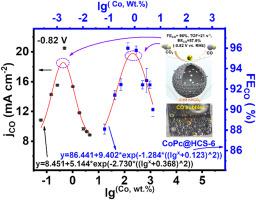Nano Energy ( IF 16.8 ) Pub Date : 2021-02-19 , DOI: 10.1016/j.nanoen.2021.105904 Shanhe Gong , Wenbo Wang , Xinxin Xiao , Jun Liu , Chundu Wu , Xiaomeng Lv

|
Heterogeneous molecular catalysts with inexpensive transition-metal centers have attracted much attention, due to their excellent electrocatalytic performance on electrocatalytic carbon dioxide reduction reaction (CO2RR). Among them, metal phthalocyanine (MePc) has aroused great interest. However, the complex existence formation (crystals or evenly dispersion) in the hybrid catalyst, e.g. cobalt (II) phthalocyanine (CoPc), determining the final electrocatalytic CO2RR performance still remains debate. To further elucidate the influence of the existence formation of CoPc on electrocatalytic performance of CO2-to-CO conversion, we synthesized ultra-thin nitrogen-doped hollow carbon spheres (N-doped HCS) with a high surface area of 653.3 m2 g−1 as the support to anchor a series of different existence formation of CoPc. The existence formation of CoPc in the hybrid catalyst is closely related with the content of Co atom, the latter of which is the key factor of the CO2RR performance. We summarized the nonlinear relationship between the partial CO current density () and the content of Co atom at −0.82 V vs. RHE, and the equation of Faraday efficiency of CO () vs. the content of Co atom at −0.82 V vs. RHE, which proves the fact that the coexistence of crystals and evenly dispersed CoPc or evenly dispersed and low loading of CoPc both could reach the satisfying results ( > ~14 mA cm−2, > ~ 91%, at −0.82 V vs. RHE) under the content of Co atom from 1.26 wt% to 0.14 wt%. The optimal catalyst (Co, 0.49 wt%) achieved a near-unity Faradaic efficiency of 96%, which is close to 4 times that of the unsupported CoPc ( =24.54%), and an outstanding current density of 20.47 mA cm−2 towards CO, which is c.a. 60 times higher than that of the unsupported CoPc (0.34 mA cm−2) at −0.82 V vs. RHE. This work could potentially inspire the rational design of heterogeneous molecular catalysts and promote its application in the energy conversion and storage field.
中文翻译:

阐明了锚固酞菁钴的存在形式对电催化CO 2到CO转化的影响
具有廉价的过渡金属中心的非均相分子催化剂,由于其对电催化二氧化碳还原反应(CO 2 RR)的优异电催化性能而备受关注。其中,金属酞菁(MePc)引起了极大的兴趣。然而,杂化催化剂(例如钴(II)酞菁(CoPc))中络合物的存在形成(晶体或均匀分散),决定最终的电催化CO 2 RR性能仍然存在争议。为了进一步阐明CoPc的存在对CO 2转化为CO的电催化性能的影响,我们合成了高表面积653.3 m 2的超薄氮掺杂空心碳球(N掺杂HCS)。g -1作为锚定一系列不同存在的CoPc的载体。杂化催化剂中CoPc的存在形成与Co原子含量密切相关,后者是影响CO 2 RR性能的关键因素。我们总结了部分CO电流密度()和-0.82 V下相对于RHE的Co原子含量以及CO(法拉第效率)方程)相对于-0.82 V下相对于RHE的Co原子含量,证明了晶体共存和CoPc均匀分散或均匀分散以及CoPc的低载量共存都可以达到令人满意的结果(>〜14 mA cm -2,当Co原子含量为1.26 wt%至0.14 wt%时,在相对于-RHE为-0.82 V时>〜91%。最佳催化剂(Co,0.49 wt%)达到了96%的接近统一的法拉第效率,接近未负载CoPc(= 24.54%),并且朝向CO的出色电流密度为20.47 mA cm -2,比-0.82 V vs.RHE的无支撑CoPc(0.34 mA cm -2)高约60倍。这项工作可能会激发多相分子催化剂的合理设计,并促进其在能量转换和存储领域的应用。











































 京公网安备 11010802027423号
京公网安备 11010802027423号